Analyzing Financial Ratios for Effective Hotel Management
VerifiedAdded on 2023/01/10
|13
|3148
|93
Report
AI Summary
This report provides a comprehensive analysis of financial ratios within the context of hotel management, using Gatsby Grange, a boutique hotel chain in the UK and Northern Ireland, as a case study. The report begins with an introduction to financial management and its significance in the hotel and tourism industry. It then delves into the calculation and analysis of various financial ratios, including profitability (net and gross profit margins), liquidity (current and quick ratios), and gearing ratios (debt-equity and equity ratios). The analysis covers trends from 2018 to 2019. The report emphasizes the importance of understanding these ratios and their fluctuations for effective hotel management, highlighting their role in assessing financial solvency, identifying trends, and supporting forecasting and planning. Furthermore, the report discusses the benefits and limitations of ratio analysis in decision-making within the hotel and tourism industry, acknowledging its role in simplifying complex financial statements and facilitating comparisons while also recognizing its limitations in ignoring qualitative aspects and inflation. The report concludes with a summary of the key findings and their implications for hotel management practices.

International hotel
management
management
Paraphrase This Document
Need a fresh take? Get an instant paraphrase of this document with our AI Paraphraser

Contents
INTRODUCTION...........................................................................................................................1
MAIN BODY..................................................................................................................................1
a) Calculating and analysing financial ratios...............................................................................1
b) Discussing why an understanding of ratios and their fluctuations is essential for Hotel
management.................................................................................................................................7
c) Benefits and limitations of ratio analysis in decision making within hotel and tourism
industry........................................................................................................................................8
CONCLUSION................................................................................................................................9
REFERENCES..............................................................................................................................10
INTRODUCTION...........................................................................................................................1
MAIN BODY..................................................................................................................................1
a) Calculating and analysing financial ratios...............................................................................1
b) Discussing why an understanding of ratios and their fluctuations is essential for Hotel
management.................................................................................................................................7
c) Benefits and limitations of ratio analysis in decision making within hotel and tourism
industry........................................................................................................................................8
CONCLUSION................................................................................................................................9
REFERENCES..............................................................................................................................10
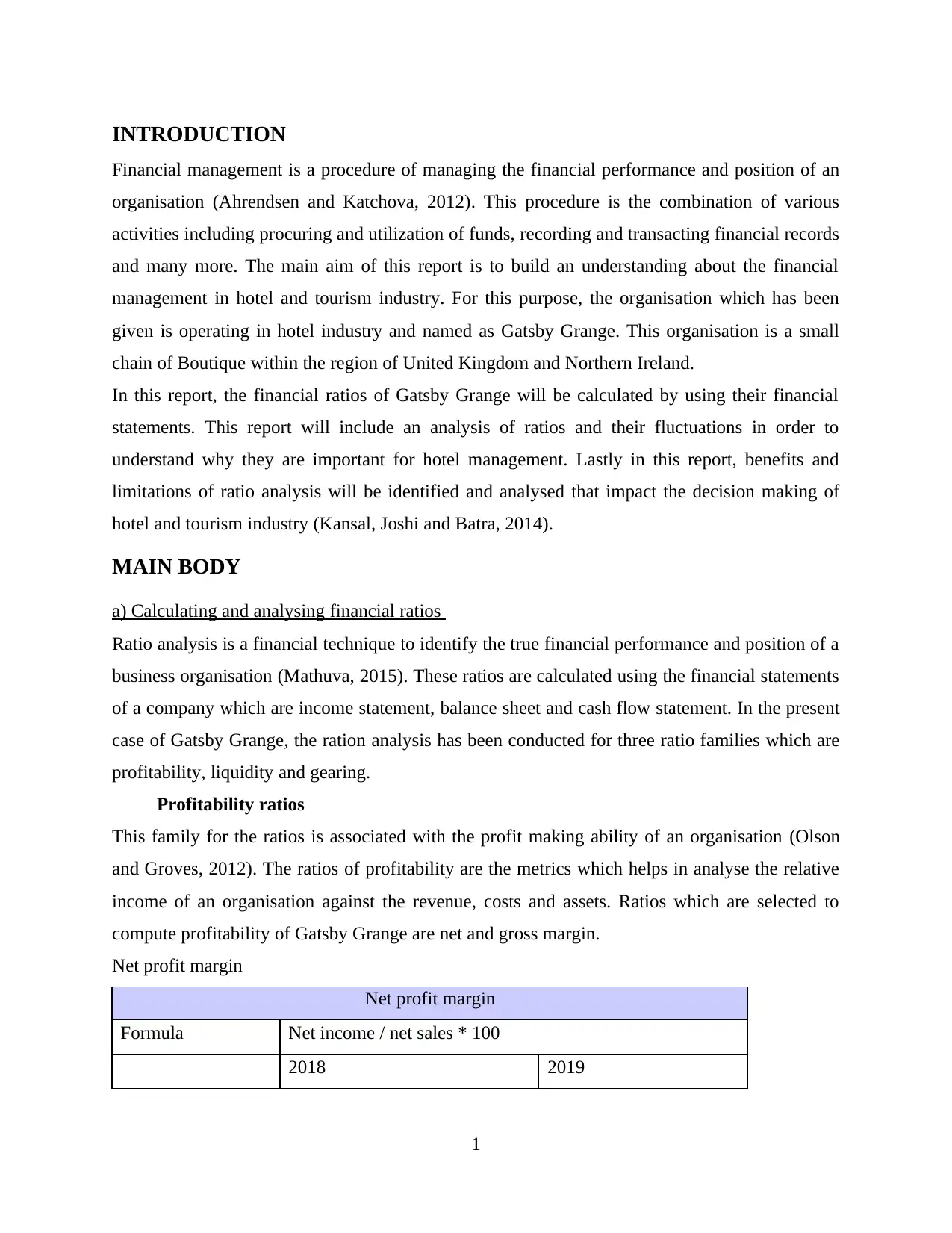
INTRODUCTION
Financial management is a procedure of managing the financial performance and position of an
organisation (Ahrendsen and Katchova, 2012). This procedure is the combination of various
activities including procuring and utilization of funds, recording and transacting financial records
and many more. The main aim of this report is to build an understanding about the financial
management in hotel and tourism industry. For this purpose, the organisation which has been
given is operating in hotel industry and named as Gatsby Grange. This organisation is a small
chain of Boutique within the region of United Kingdom and Northern Ireland.
In this report, the financial ratios of Gatsby Grange will be calculated by using their financial
statements. This report will include an analysis of ratios and their fluctuations in order to
understand why they are important for hotel management. Lastly in this report, benefits and
limitations of ratio analysis will be identified and analysed that impact the decision making of
hotel and tourism industry (Kansal, Joshi and Batra, 2014).
MAIN BODY
a) Calculating and analysing financial ratios
Ratio analysis is a financial technique to identify the true financial performance and position of a
business organisation (Mathuva, 2015). These ratios are calculated using the financial statements
of a company which are income statement, balance sheet and cash flow statement. In the present
case of Gatsby Grange, the ration analysis has been conducted for three ratio families which are
profitability, liquidity and gearing.
Profitability ratios
This family for the ratios is associated with the profit making ability of an organisation (Olson
and Groves, 2012). The ratios of profitability are the metrics which helps in analyse the relative
income of an organisation against the revenue, costs and assets. Ratios which are selected to
compute profitability of Gatsby Grange are net and gross margin.
Net profit margin
Net profit margin
Formula Net income / net sales * 100
2018 2019
1
Financial management is a procedure of managing the financial performance and position of an
organisation (Ahrendsen and Katchova, 2012). This procedure is the combination of various
activities including procuring and utilization of funds, recording and transacting financial records
and many more. The main aim of this report is to build an understanding about the financial
management in hotel and tourism industry. For this purpose, the organisation which has been
given is operating in hotel industry and named as Gatsby Grange. This organisation is a small
chain of Boutique within the region of United Kingdom and Northern Ireland.
In this report, the financial ratios of Gatsby Grange will be calculated by using their financial
statements. This report will include an analysis of ratios and their fluctuations in order to
understand why they are important for hotel management. Lastly in this report, benefits and
limitations of ratio analysis will be identified and analysed that impact the decision making of
hotel and tourism industry (Kansal, Joshi and Batra, 2014).
MAIN BODY
a) Calculating and analysing financial ratios
Ratio analysis is a financial technique to identify the true financial performance and position of a
business organisation (Mathuva, 2015). These ratios are calculated using the financial statements
of a company which are income statement, balance sheet and cash flow statement. In the present
case of Gatsby Grange, the ration analysis has been conducted for three ratio families which are
profitability, liquidity and gearing.
Profitability ratios
This family for the ratios is associated with the profit making ability of an organisation (Olson
and Groves, 2012). The ratios of profitability are the metrics which helps in analyse the relative
income of an organisation against the revenue, costs and assets. Ratios which are selected to
compute profitability of Gatsby Grange are net and gross margin.
Net profit margin
Net profit margin
Formula Net income / net sales * 100
2018 2019
1
⊘ This is a preview!⊘
Do you want full access?
Subscribe today to unlock all pages.

Trusted by 1+ million students worldwide
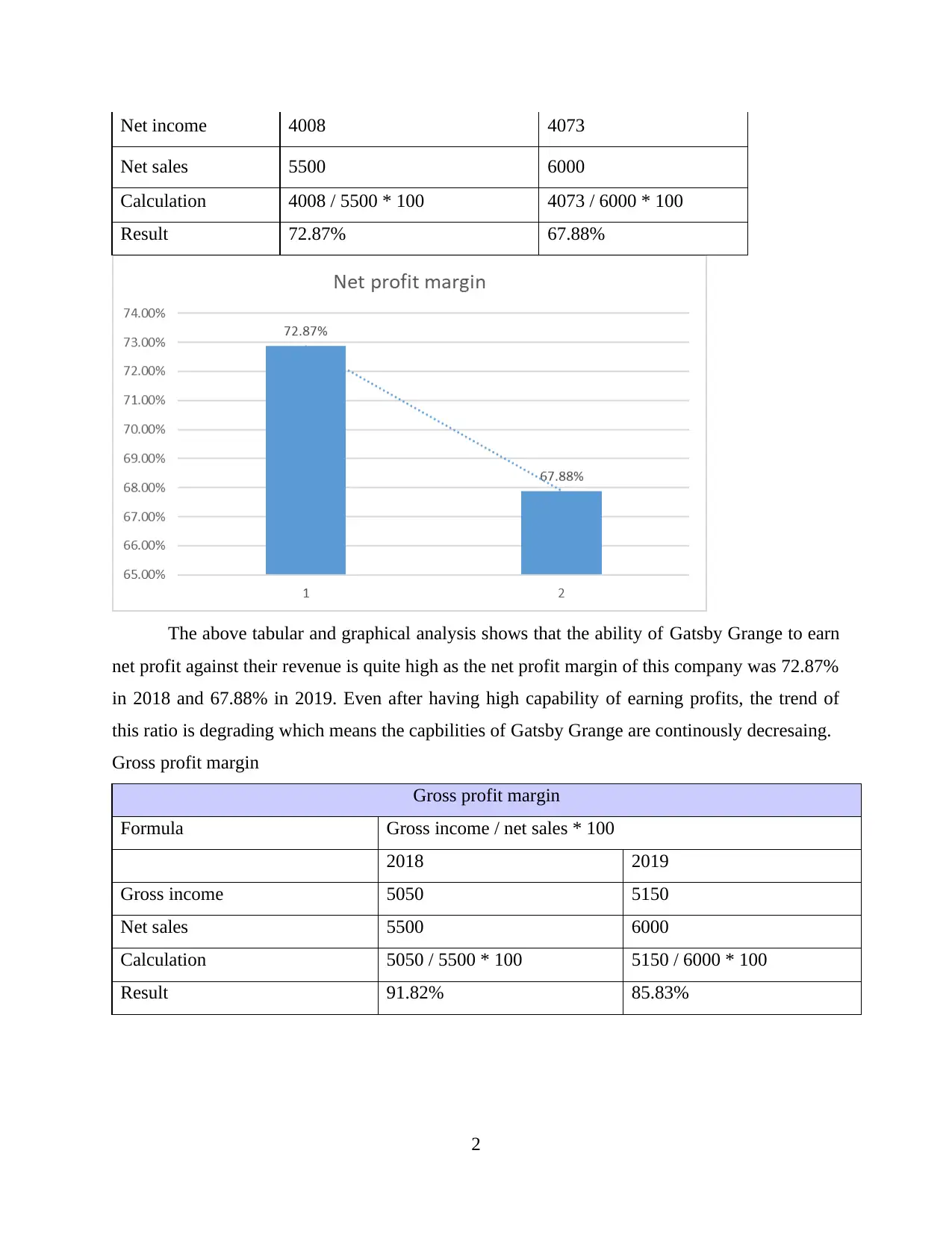
Net income 4008 4073
Net sales 5500 6000
Calculation 4008 / 5500 * 100 4073 / 6000 * 100
Result 72.87% 67.88%
The above tabular and graphical analysis shows that the ability of Gatsby Grange to earn
net profit against their revenue is quite high as the net profit margin of this company was 72.87%
in 2018 and 67.88% in 2019. Even after having high capability of earning profits, the trend of
this ratio is degrading which means the capbilities of Gatsby Grange are continously decresaing.
Gross profit margin
Gross profit margin
Formula Gross income / net sales * 100
2018 2019
Gross income 5050 5150
Net sales 5500 6000
Calculation 5050 / 5500 * 100 5150 / 6000 * 100
Result 91.82% 85.83%
2
Net sales 5500 6000
Calculation 4008 / 5500 * 100 4073 / 6000 * 100
Result 72.87% 67.88%
The above tabular and graphical analysis shows that the ability of Gatsby Grange to earn
net profit against their revenue is quite high as the net profit margin of this company was 72.87%
in 2018 and 67.88% in 2019. Even after having high capability of earning profits, the trend of
this ratio is degrading which means the capbilities of Gatsby Grange are continously decresaing.
Gross profit margin
Gross profit margin
Formula Gross income / net sales * 100
2018 2019
Gross income 5050 5150
Net sales 5500 6000
Calculation 5050 / 5500 * 100 5150 / 6000 * 100
Result 91.82% 85.83%
2
Paraphrase This Document
Need a fresh take? Get an instant paraphrase of this document with our AI Paraphraser
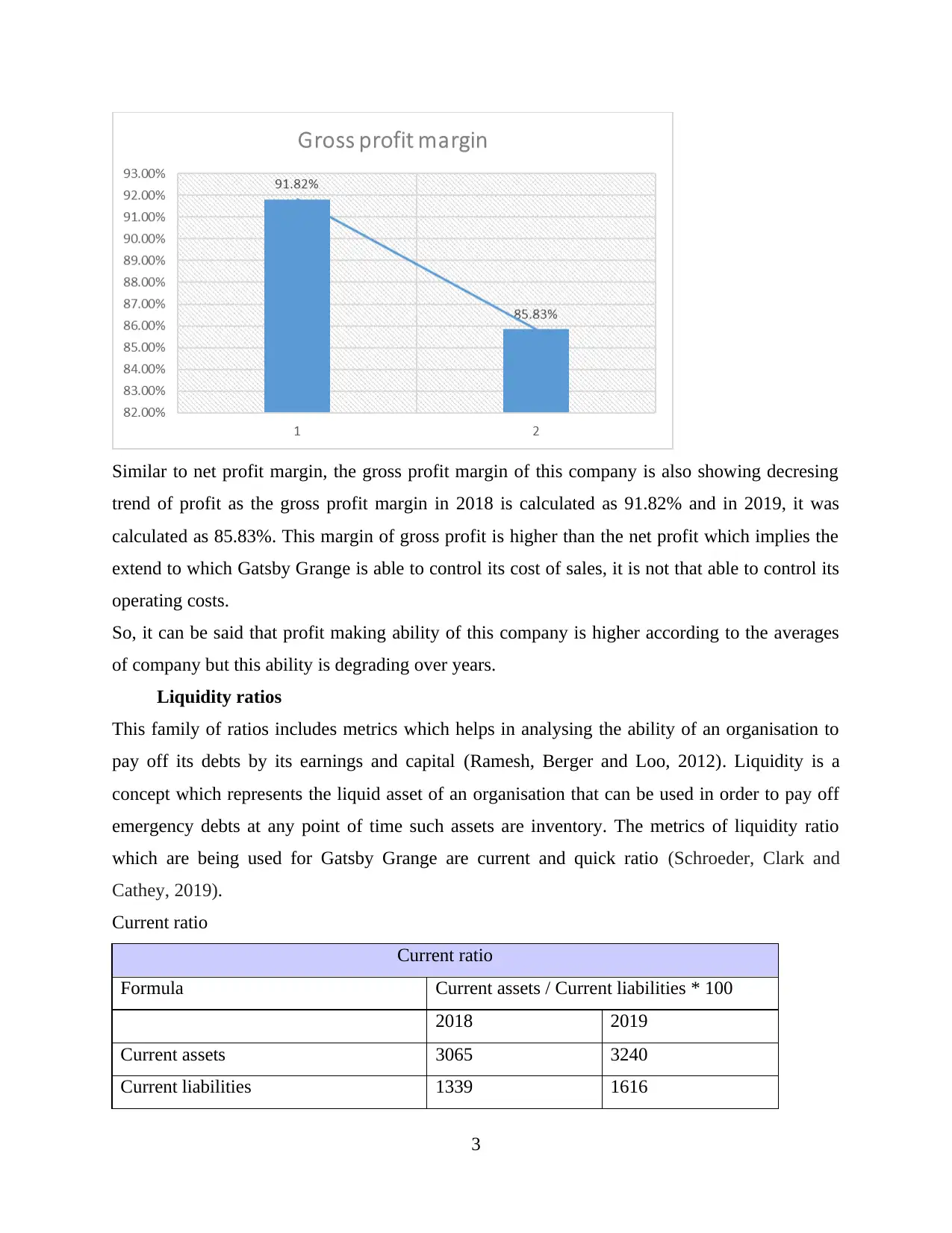
Similar to net profit margin, the gross profit margin of this company is also showing decresing
trend of profit as the gross profit margin in 2018 is calculated as 91.82% and in 2019, it was
calculated as 85.83%. This margin of gross profit is higher than the net profit which implies the
extend to which Gatsby Grange is able to control its cost of sales, it is not that able to control its
operating costs.
So, it can be said that profit making ability of this company is higher according to the averages
of company but this ability is degrading over years.
Liquidity ratios
This family of ratios includes metrics which helps in analysing the ability of an organisation to
pay off its debts by its earnings and capital (Ramesh, Berger and Loo, 2012). Liquidity is a
concept which represents the liquid asset of an organisation that can be used in order to pay off
emergency debts at any point of time such assets are inventory. The metrics of liquidity ratio
which are being used for Gatsby Grange are current and quick ratio (Schroeder, Clark and
Cathey, 2019).
Current ratio
Current ratio
Formula Current assets / Current liabilities * 100
2018 2019
Current assets 3065 3240
Current liabilities 1339 1616
3
trend of profit as the gross profit margin in 2018 is calculated as 91.82% and in 2019, it was
calculated as 85.83%. This margin of gross profit is higher than the net profit which implies the
extend to which Gatsby Grange is able to control its cost of sales, it is not that able to control its
operating costs.
So, it can be said that profit making ability of this company is higher according to the averages
of company but this ability is degrading over years.
Liquidity ratios
This family of ratios includes metrics which helps in analysing the ability of an organisation to
pay off its debts by its earnings and capital (Ramesh, Berger and Loo, 2012). Liquidity is a
concept which represents the liquid asset of an organisation that can be used in order to pay off
emergency debts at any point of time such assets are inventory. The metrics of liquidity ratio
which are being used for Gatsby Grange are current and quick ratio (Schroeder, Clark and
Cathey, 2019).
Current ratio
Current ratio
Formula Current assets / Current liabilities * 100
2018 2019
Current assets 3065 3240
Current liabilities 1339 1616
3

Calculation 3065 / 1339 3240 / 1616
Result 2.289021658 2.004950495
Above tabular analysis is representing the formula of current ratio which is the remainder
between the current assets and current liabilities. The above graph shows that the trend of current
ratio is decresaing as the ratio of Gatsby Grange has changed from 2.28: 1 to 2.00: 1 in just one
year. According to the ideal ratio of the industry, in both the years, the current ratio of this
company is sufficient but a decreasing ratio is not a good sign (Revelli and Viviani, 2015).
Quick ratio
Quick ratio
Formula Quick assets / Current liabilities * 100
2018 2019
Quick assets (Current assets - Inventory) (3065 - 1450) = 1615 (3240 - 1420) = 1820
Current liabilities 1339 1616
Calculation 1615 / 1339 1820 / 1616
Result 1.206123973 1.126237624
4
Result 2.289021658 2.004950495
Above tabular analysis is representing the formula of current ratio which is the remainder
between the current assets and current liabilities. The above graph shows that the trend of current
ratio is decresaing as the ratio of Gatsby Grange has changed from 2.28: 1 to 2.00: 1 in just one
year. According to the ideal ratio of the industry, in both the years, the current ratio of this
company is sufficient but a decreasing ratio is not a good sign (Revelli and Viviani, 2015).
Quick ratio
Quick ratio
Formula Quick assets / Current liabilities * 100
2018 2019
Quick assets (Current assets - Inventory) (3065 - 1450) = 1615 (3240 - 1420) = 1820
Current liabilities 1339 1616
Calculation 1615 / 1339 1820 / 1616
Result 1.206123973 1.126237624
4
⊘ This is a preview!⊘
Do you want full access?
Subscribe today to unlock all pages.

Trusted by 1+ million students worldwide
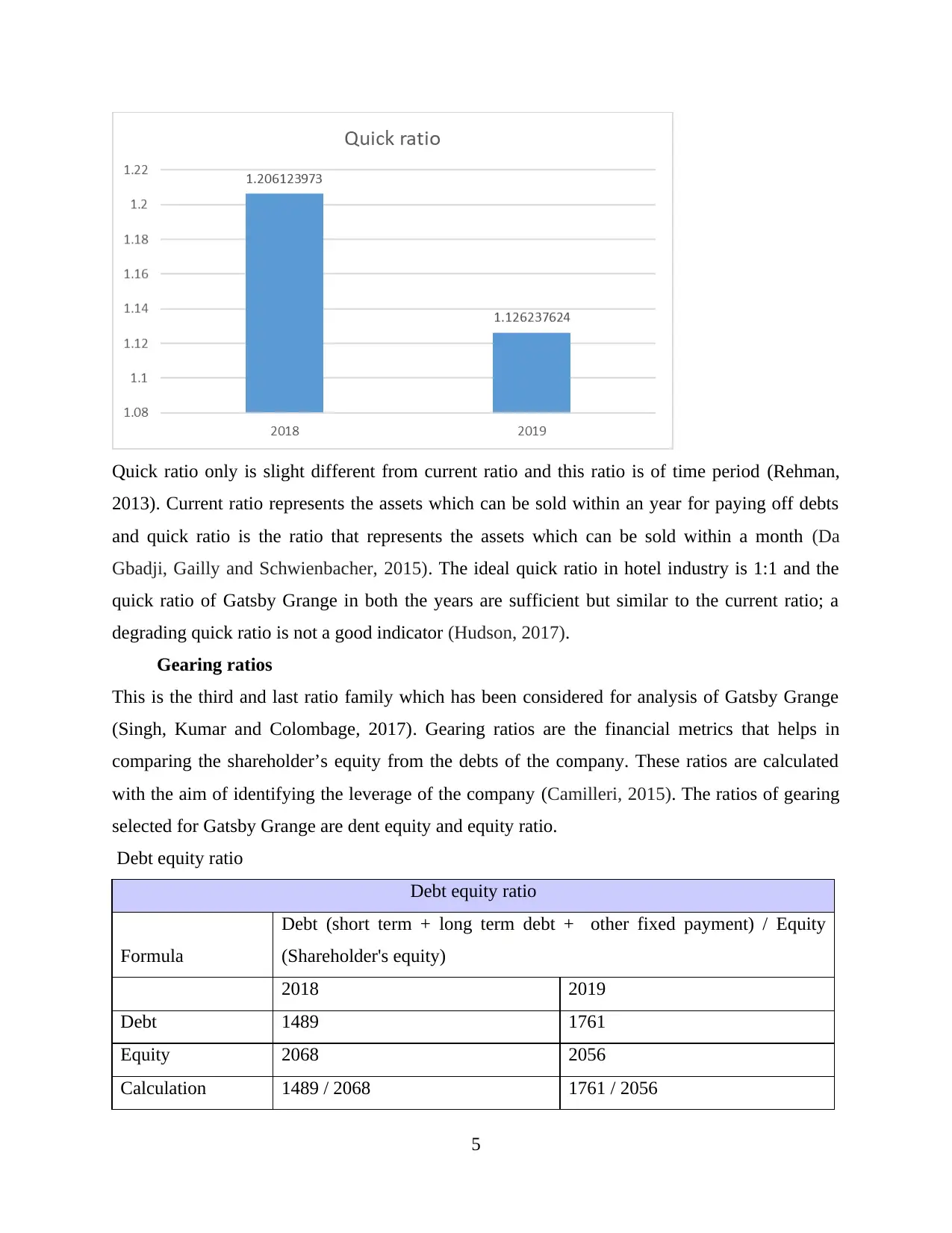
Quick ratio only is slight different from current ratio and this ratio is of time period (Rehman,
2013). Current ratio represents the assets which can be sold within an year for paying off debts
and quick ratio is the ratio that represents the assets which can be sold within a month (Da
Gbadji, Gailly and Schwienbacher, 2015). The ideal quick ratio in hotel industry is 1:1 and the
quick ratio of Gatsby Grange in both the years are sufficient but similar to the current ratio; a
degrading quick ratio is not a good indicator (Hudson, 2017).
Gearing ratios
This is the third and last ratio family which has been considered for analysis of Gatsby Grange
(Singh, Kumar and Colombage, 2017). Gearing ratios are the financial metrics that helps in
comparing the shareholder’s equity from the debts of the company. These ratios are calculated
with the aim of identifying the leverage of the company (Camilleri, 2015). The ratios of gearing
selected for Gatsby Grange are dent equity and equity ratio.
Debt equity ratio
Debt equity ratio
Formula
Debt (short term + long term debt + other fixed payment) / Equity
(Shareholder's equity)
2018 2019
Debt 1489 1761
Equity 2068 2056
Calculation 1489 / 2068 1761 / 2056
5
2013). Current ratio represents the assets which can be sold within an year for paying off debts
and quick ratio is the ratio that represents the assets which can be sold within a month (Da
Gbadji, Gailly and Schwienbacher, 2015). The ideal quick ratio in hotel industry is 1:1 and the
quick ratio of Gatsby Grange in both the years are sufficient but similar to the current ratio; a
degrading quick ratio is not a good indicator (Hudson, 2017).
Gearing ratios
This is the third and last ratio family which has been considered for analysis of Gatsby Grange
(Singh, Kumar and Colombage, 2017). Gearing ratios are the financial metrics that helps in
comparing the shareholder’s equity from the debts of the company. These ratios are calculated
with the aim of identifying the leverage of the company (Camilleri, 2015). The ratios of gearing
selected for Gatsby Grange are dent equity and equity ratio.
Debt equity ratio
Debt equity ratio
Formula
Debt (short term + long term debt + other fixed payment) / Equity
(Shareholder's equity)
2018 2019
Debt 1489 1761
Equity 2068 2056
Calculation 1489 / 2068 1761 / 2056
5
Paraphrase This Document
Need a fresh take? Get an instant paraphrase of this document with our AI Paraphraser

Result 0.720019342 0.85651751
This ratio of debt equity helps in caluclating the ability of an organisation to pay off its debts
from its equity (Capkun, Collins and Jeanjean, 2016). The ratio of debt equity is similar to the
current ratio but there is a difference that current ratio is used to caclulate a company’s ability to
pay its short term debts and debt equity ratio is used to pay off long term debts (Christensen and
et.al., 2015). The above tabular and graphical representation shows that the debt equity ratio of
Gatsby Grange is sufficient in any year. An affirmative trend has been observed in debt equity
ratio as this ratio has increased from 2018 to 2019.
Equity ratio
Equity ratio
Formula Shareholder's equity / Total assets
2018 2019
Shareholder's equity 2068 2056
Total assets 7565 7890
Calculation 2068 / 7565 2056 / 7890
Result 0.273364177 0.260583016
6
This ratio of debt equity helps in caluclating the ability of an organisation to pay off its debts
from its equity (Capkun, Collins and Jeanjean, 2016). The ratio of debt equity is similar to the
current ratio but there is a difference that current ratio is used to caclulate a company’s ability to
pay its short term debts and debt equity ratio is used to pay off long term debts (Christensen and
et.al., 2015). The above tabular and graphical representation shows that the debt equity ratio of
Gatsby Grange is sufficient in any year. An affirmative trend has been observed in debt equity
ratio as this ratio has increased from 2018 to 2019.
Equity ratio
Equity ratio
Formula Shareholder's equity / Total assets
2018 2019
Shareholder's equity 2068 2056
Total assets 7565 7890
Calculation 2068 / 7565 2056 / 7890
Result 0.273364177 0.260583016
6

This particular ratio of equity is used to compare the equity position of an organisation when
compared to total assets of a company (Clatworthy and Peel, 2016). The above graph is
representing a clear decresing trend of this ratio which implies that the leverage Gatsby Grange
was entertaining has begun to decrease that can impact the equity position of this company.
b) Discussing why an understanding of ratios and their fluctuations is essential for Hotel
management
Every organisation operating in any industry has its primary aim to earn profit and increase
revenues for which they seek investments from external parties. This investment is provided to
the business organisations after analysing the financial performance and position of the company
(De George, Li and Shivakumar, 2016). There are various techniques through which this analysis
can be done and one of the most effective techniques is ratio analysis. This technique of ratio
analysis allows to analyse the information seen in the financial statements as ratios represents the
summary financials of a company.
Hotel management is a procedure in which operations and financials of a hotel are analysed (De
Simone, 2016). In this case, Gatsby Grange is given as the organisation in hotel industry. For
hotel management, it is important to understand ratios and its fluctuation due to various reasons
mentioned below:
Measure of financial solvency – Financial statements of an organisation provides information in
a form of summary (Flower and Ebbers, 2018). This summary is gained from all the transactions
that are being undertaken in an accounting year. Just by looking at the financial statements, it is
7
compared to total assets of a company (Clatworthy and Peel, 2016). The above graph is
representing a clear decresing trend of this ratio which implies that the leverage Gatsby Grange
was entertaining has begun to decrease that can impact the equity position of this company.
b) Discussing why an understanding of ratios and their fluctuations is essential for Hotel
management
Every organisation operating in any industry has its primary aim to earn profit and increase
revenues for which they seek investments from external parties. This investment is provided to
the business organisations after analysing the financial performance and position of the company
(De George, Li and Shivakumar, 2016). There are various techniques through which this analysis
can be done and one of the most effective techniques is ratio analysis. This technique of ratio
analysis allows to analyse the information seen in the financial statements as ratios represents the
summary financials of a company.
Hotel management is a procedure in which operations and financials of a hotel are analysed (De
Simone, 2016). In this case, Gatsby Grange is given as the organisation in hotel industry. For
hotel management, it is important to understand ratios and its fluctuation due to various reasons
mentioned below:
Measure of financial solvency – Financial statements of an organisation provides information in
a form of summary (Flower and Ebbers, 2018). This summary is gained from all the transactions
that are being undertaken in an accounting year. Just by looking at the financial statements, it is
7
⊘ This is a preview!⊘
Do you want full access?
Subscribe today to unlock all pages.

Trusted by 1+ million students worldwide
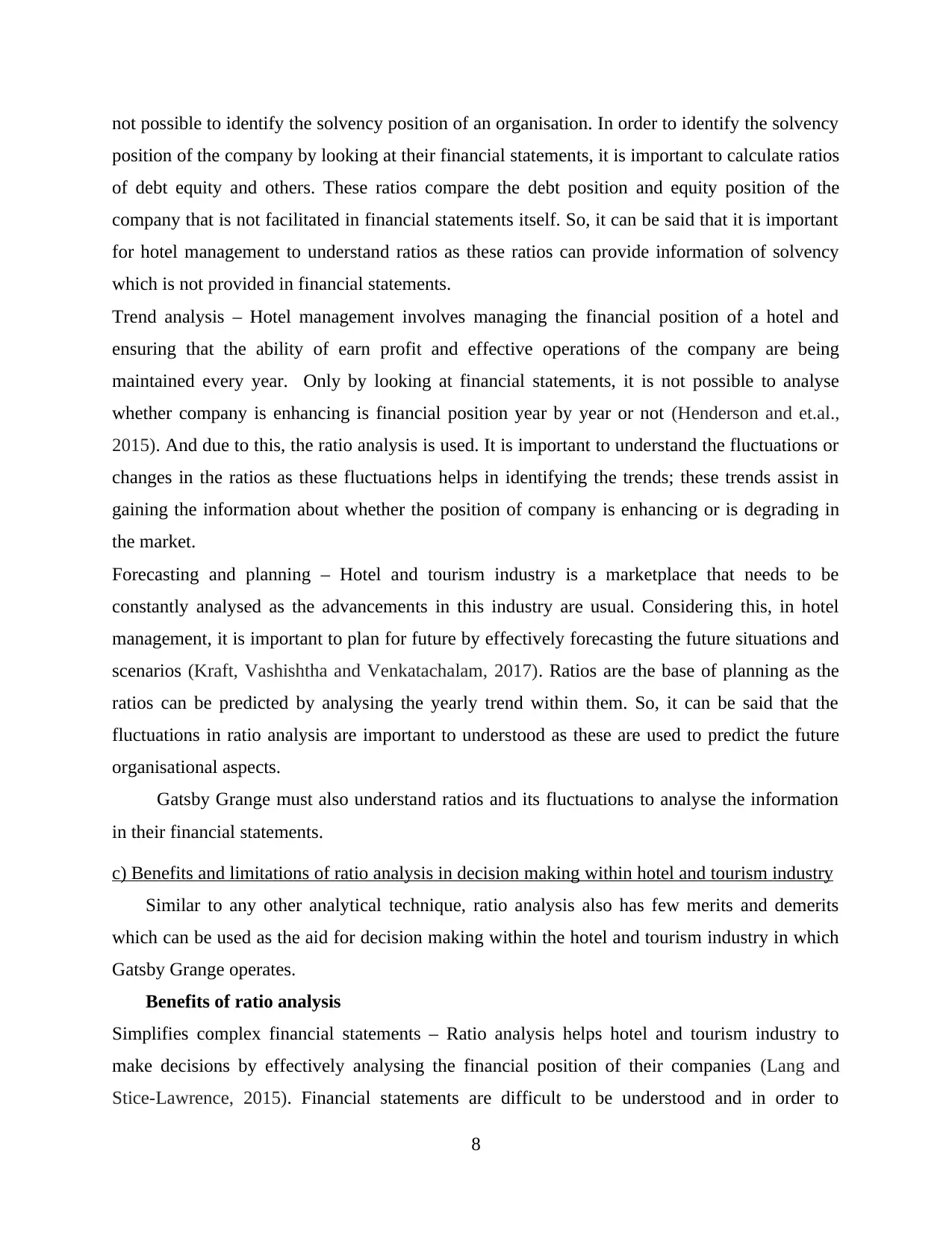
not possible to identify the solvency position of an organisation. In order to identify the solvency
position of the company by looking at their financial statements, it is important to calculate ratios
of debt equity and others. These ratios compare the debt position and equity position of the
company that is not facilitated in financial statements itself. So, it can be said that it is important
for hotel management to understand ratios as these ratios can provide information of solvency
which is not provided in financial statements.
Trend analysis – Hotel management involves managing the financial position of a hotel and
ensuring that the ability of earn profit and effective operations of the company are being
maintained every year. Only by looking at financial statements, it is not possible to analyse
whether company is enhancing is financial position year by year or not (Henderson and et.al.,
2015). And due to this, the ratio analysis is used. It is important to understand the fluctuations or
changes in the ratios as these fluctuations helps in identifying the trends; these trends assist in
gaining the information about whether the position of company is enhancing or is degrading in
the market.
Forecasting and planning – Hotel and tourism industry is a marketplace that needs to be
constantly analysed as the advancements in this industry are usual. Considering this, in hotel
management, it is important to plan for future by effectively forecasting the future situations and
scenarios (Kraft, Vashishtha and Venkatachalam, 2017). Ratios are the base of planning as the
ratios can be predicted by analysing the yearly trend within them. So, it can be said that the
fluctuations in ratio analysis are important to understood as these are used to predict the future
organisational aspects.
Gatsby Grange must also understand ratios and its fluctuations to analyse the information
in their financial statements.
c) Benefits and limitations of ratio analysis in decision making within hotel and tourism industry
Similar to any other analytical technique, ratio analysis also has few merits and demerits
which can be used as the aid for decision making within the hotel and tourism industry in which
Gatsby Grange operates.
Benefits of ratio analysis
Simplifies complex financial statements – Ratio analysis helps hotel and tourism industry to
make decisions by effectively analysing the financial position of their companies (Lang and
Stice-Lawrence, 2015). Financial statements are difficult to be understood and in order to
8
position of the company by looking at their financial statements, it is important to calculate ratios
of debt equity and others. These ratios compare the debt position and equity position of the
company that is not facilitated in financial statements itself. So, it can be said that it is important
for hotel management to understand ratios as these ratios can provide information of solvency
which is not provided in financial statements.
Trend analysis – Hotel management involves managing the financial position of a hotel and
ensuring that the ability of earn profit and effective operations of the company are being
maintained every year. Only by looking at financial statements, it is not possible to analyse
whether company is enhancing is financial position year by year or not (Henderson and et.al.,
2015). And due to this, the ratio analysis is used. It is important to understand the fluctuations or
changes in the ratios as these fluctuations helps in identifying the trends; these trends assist in
gaining the information about whether the position of company is enhancing or is degrading in
the market.
Forecasting and planning – Hotel and tourism industry is a marketplace that needs to be
constantly analysed as the advancements in this industry are usual. Considering this, in hotel
management, it is important to plan for future by effectively forecasting the future situations and
scenarios (Kraft, Vashishtha and Venkatachalam, 2017). Ratios are the base of planning as the
ratios can be predicted by analysing the yearly trend within them. So, it can be said that the
fluctuations in ratio analysis are important to understood as these are used to predict the future
organisational aspects.
Gatsby Grange must also understand ratios and its fluctuations to analyse the information
in their financial statements.
c) Benefits and limitations of ratio analysis in decision making within hotel and tourism industry
Similar to any other analytical technique, ratio analysis also has few merits and demerits
which can be used as the aid for decision making within the hotel and tourism industry in which
Gatsby Grange operates.
Benefits of ratio analysis
Simplifies complex financial statements – Ratio analysis helps hotel and tourism industry to
make decisions by effectively analysing the financial position of their companies (Lang and
Stice-Lawrence, 2015). Financial statements are difficult to be understood and in order to
8
Paraphrase This Document
Need a fresh take? Get an instant paraphrase of this document with our AI Paraphraser
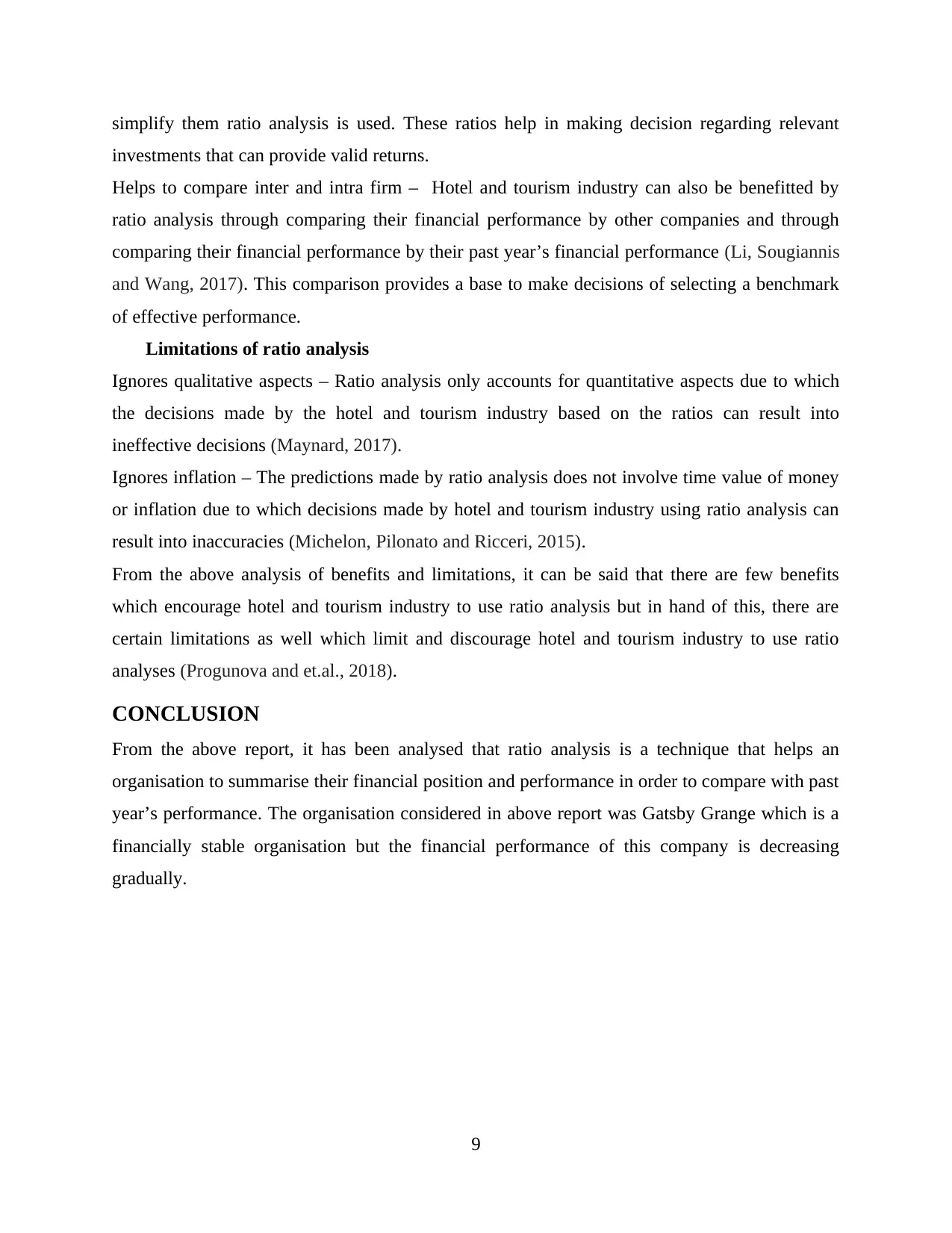
simplify them ratio analysis is used. These ratios help in making decision regarding relevant
investments that can provide valid returns.
Helps to compare inter and intra firm – Hotel and tourism industry can also be benefitted by
ratio analysis through comparing their financial performance by other companies and through
comparing their financial performance by their past year’s financial performance (Li, Sougiannis
and Wang, 2017). This comparison provides a base to make decisions of selecting a benchmark
of effective performance.
Limitations of ratio analysis
Ignores qualitative aspects – Ratio analysis only accounts for quantitative aspects due to which
the decisions made by the hotel and tourism industry based on the ratios can result into
ineffective decisions (Maynard, 2017).
Ignores inflation – The predictions made by ratio analysis does not involve time value of money
or inflation due to which decisions made by hotel and tourism industry using ratio analysis can
result into inaccuracies (Michelon, Pilonato and Ricceri, 2015).
From the above analysis of benefits and limitations, it can be said that there are few benefits
which encourage hotel and tourism industry to use ratio analysis but in hand of this, there are
certain limitations as well which limit and discourage hotel and tourism industry to use ratio
analyses (Progunova and et.al., 2018).
CONCLUSION
From the above report, it has been analysed that ratio analysis is a technique that helps an
organisation to summarise their financial position and performance in order to compare with past
year’s performance. The organisation considered in above report was Gatsby Grange which is a
financially stable organisation but the financial performance of this company is decreasing
gradually.
9
investments that can provide valid returns.
Helps to compare inter and intra firm – Hotel and tourism industry can also be benefitted by
ratio analysis through comparing their financial performance by other companies and through
comparing their financial performance by their past year’s financial performance (Li, Sougiannis
and Wang, 2017). This comparison provides a base to make decisions of selecting a benchmark
of effective performance.
Limitations of ratio analysis
Ignores qualitative aspects – Ratio analysis only accounts for quantitative aspects due to which
the decisions made by the hotel and tourism industry based on the ratios can result into
ineffective decisions (Maynard, 2017).
Ignores inflation – The predictions made by ratio analysis does not involve time value of money
or inflation due to which decisions made by hotel and tourism industry using ratio analysis can
result into inaccuracies (Michelon, Pilonato and Ricceri, 2015).
From the above analysis of benefits and limitations, it can be said that there are few benefits
which encourage hotel and tourism industry to use ratio analysis but in hand of this, there are
certain limitations as well which limit and discourage hotel and tourism industry to use ratio
analyses (Progunova and et.al., 2018).
CONCLUSION
From the above report, it has been analysed that ratio analysis is a technique that helps an
organisation to summarise their financial position and performance in order to compare with past
year’s performance. The organisation considered in above report was Gatsby Grange which is a
financially stable organisation but the financial performance of this company is decreasing
gradually.
9

REFERENCES
Books and Journals
Ahrendsen, B.L. and Katchova, A.L., 2012. Financial ratio analysis using ARMS data (No.
1639-2016-135182).
Kansal, M., Joshi, M. and Batra, G.S., 2014. Determinants of corporate social responsibility
disclosures: Evidence from India. Advances in Accounting. 30(1). pp.217-229.
Mathuva, D., 2015. The Influence of working capital management components on corporate
profitability.
Olson, K. and Groves, R.M., 2012. An examination of within-person variation in response
propensity over the data collection field period.
Ramesh, A., Berger, P.R. and Loo, R., 2012. High 5.2 peak-to-valley current ratio in Si/SiGe
resonant interband tunnel diodes grown by chemical vapor deposition. Applied Physics
Letters. 100(9). p.092104.
Rehman, S.S.F.U., 2013. Relationship between financial leverage and financial performance:
Empirical evidence of listed sugar companies of Pakistan. Global Journal of
Management and Business Research.
Singh, H.P., Kumar, S. and Colombage, S., 2017. Working capital management and firm
profitability: a meta-analysis. Qualitative Research in Financial Markets.
Camilleri, M.A., 2015. Valuing stakeholder engagement and sustainability reporting. Corporate
Reputation Review. 18(3). pp.210-222.
Capkun, V., Collins, D. and Jeanjean, T., 2016. The effect of IAS/IFRS adoption on earnings
management (smoothing): A closer look at competing explanations. Journal of
Accounting and Public Policy. 35(4). pp.352-394.
Christensen, H. B. and et.al., 2015. Incentives or standards: What determines accounting quality
changes around IFRS adoption?. European Accounting Review. 24(1). pp.31-61.
Clatworthy, M.A. and Peel, M.J., 2016. The timeliness of UK private company financial
reporting: Regulatory and economic influences. The British Accounting Review.48(3).
pp.297-315.
De George, E. T., Li, X. and Shivakumar, L., 2016. A review of the IFRS adoption
literature. Review of Accounting Studies. 21(3). pp.898-1004.
De Simone, L., 2016. Does a common set of accounting standards affect tax-motivated income
shifting for multinational firms?. Journal of Accounting and Economics. 61(1). pp.145-
165.
Flower, J. and Ebbers, G., 2018. Global financial reporting. Macmillan International Higher
Education.
Henderson, S. and et.al., 2015. Issues in financial accounting. Pearson Higher Education AU.
Kraft, A. G., Vashishtha, R. and Venkatachalam, M., 2017. Frequent financial reporting and
managerial myopia. The Accounting Review. 93(2). pp.249-275.
Lang, M. and Stice-Lawrence, L., 2015. Textual analysis and international financial reporting:
Large sample evidence. Journal of Accounting and Economics. 60(2-3). pp.110-135.
Li, S., Sougiannis, T. and Wang, S., 2017. Mandatory IFRS Adoption and the Usefulness of
Accounting Information in Predicting Future Earnings and Cash Flows. Available at
SSRN 2948775.
Maynard, J., 2017. Financial accounting, reporting, and analysis. Oxford University Press.
10
Books and Journals
Ahrendsen, B.L. and Katchova, A.L., 2012. Financial ratio analysis using ARMS data (No.
1639-2016-135182).
Kansal, M., Joshi, M. and Batra, G.S., 2014. Determinants of corporate social responsibility
disclosures: Evidence from India. Advances in Accounting. 30(1). pp.217-229.
Mathuva, D., 2015. The Influence of working capital management components on corporate
profitability.
Olson, K. and Groves, R.M., 2012. An examination of within-person variation in response
propensity over the data collection field period.
Ramesh, A., Berger, P.R. and Loo, R., 2012. High 5.2 peak-to-valley current ratio in Si/SiGe
resonant interband tunnel diodes grown by chemical vapor deposition. Applied Physics
Letters. 100(9). p.092104.
Rehman, S.S.F.U., 2013. Relationship between financial leverage and financial performance:
Empirical evidence of listed sugar companies of Pakistan. Global Journal of
Management and Business Research.
Singh, H.P., Kumar, S. and Colombage, S., 2017. Working capital management and firm
profitability: a meta-analysis. Qualitative Research in Financial Markets.
Camilleri, M.A., 2015. Valuing stakeholder engagement and sustainability reporting. Corporate
Reputation Review. 18(3). pp.210-222.
Capkun, V., Collins, D. and Jeanjean, T., 2016. The effect of IAS/IFRS adoption on earnings
management (smoothing): A closer look at competing explanations. Journal of
Accounting and Public Policy. 35(4). pp.352-394.
Christensen, H. B. and et.al., 2015. Incentives or standards: What determines accounting quality
changes around IFRS adoption?. European Accounting Review. 24(1). pp.31-61.
Clatworthy, M.A. and Peel, M.J., 2016. The timeliness of UK private company financial
reporting: Regulatory and economic influences. The British Accounting Review.48(3).
pp.297-315.
De George, E. T., Li, X. and Shivakumar, L., 2016. A review of the IFRS adoption
literature. Review of Accounting Studies. 21(3). pp.898-1004.
De Simone, L., 2016. Does a common set of accounting standards affect tax-motivated income
shifting for multinational firms?. Journal of Accounting and Economics. 61(1). pp.145-
165.
Flower, J. and Ebbers, G., 2018. Global financial reporting. Macmillan International Higher
Education.
Henderson, S. and et.al., 2015. Issues in financial accounting. Pearson Higher Education AU.
Kraft, A. G., Vashishtha, R. and Venkatachalam, M., 2017. Frequent financial reporting and
managerial myopia. The Accounting Review. 93(2). pp.249-275.
Lang, M. and Stice-Lawrence, L., 2015. Textual analysis and international financial reporting:
Large sample evidence. Journal of Accounting and Economics. 60(2-3). pp.110-135.
Li, S., Sougiannis, T. and Wang, S., 2017. Mandatory IFRS Adoption and the Usefulness of
Accounting Information in Predicting Future Earnings and Cash Flows. Available at
SSRN 2948775.
Maynard, J., 2017. Financial accounting, reporting, and analysis. Oxford University Press.
10
⊘ This is a preview!⊘
Do you want full access?
Subscribe today to unlock all pages.

Trusted by 1+ million students worldwide
1 out of 13
Related Documents
Your All-in-One AI-Powered Toolkit for Academic Success.
+13062052269
info@desklib.com
Available 24*7 on WhatsApp / Email
![[object Object]](/_next/static/media/star-bottom.7253800d.svg)
Unlock your academic potential
Copyright © 2020–2026 A2Z Services. All Rights Reserved. Developed and managed by ZUCOL.





